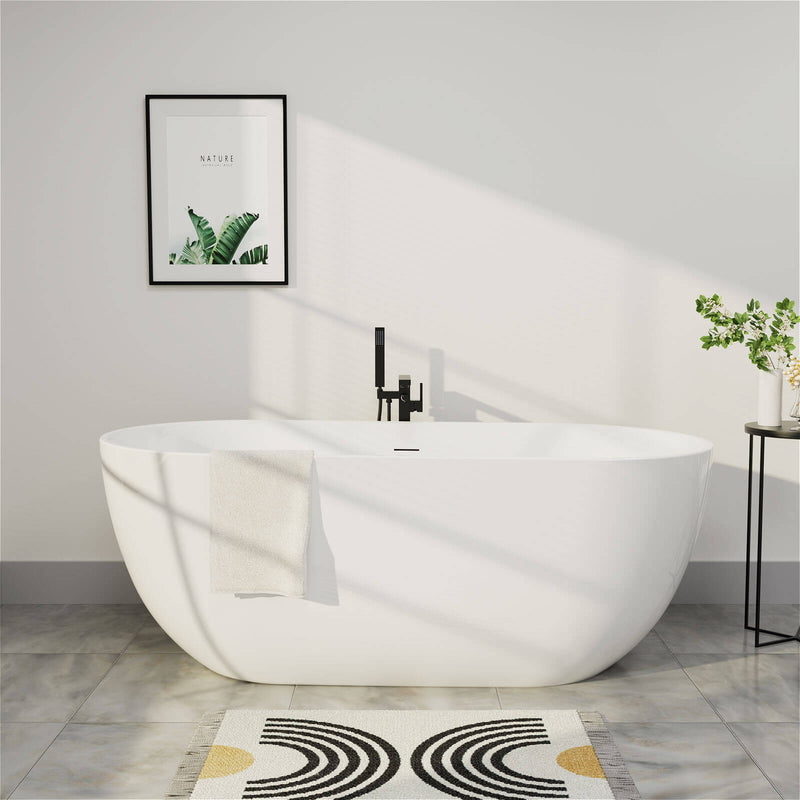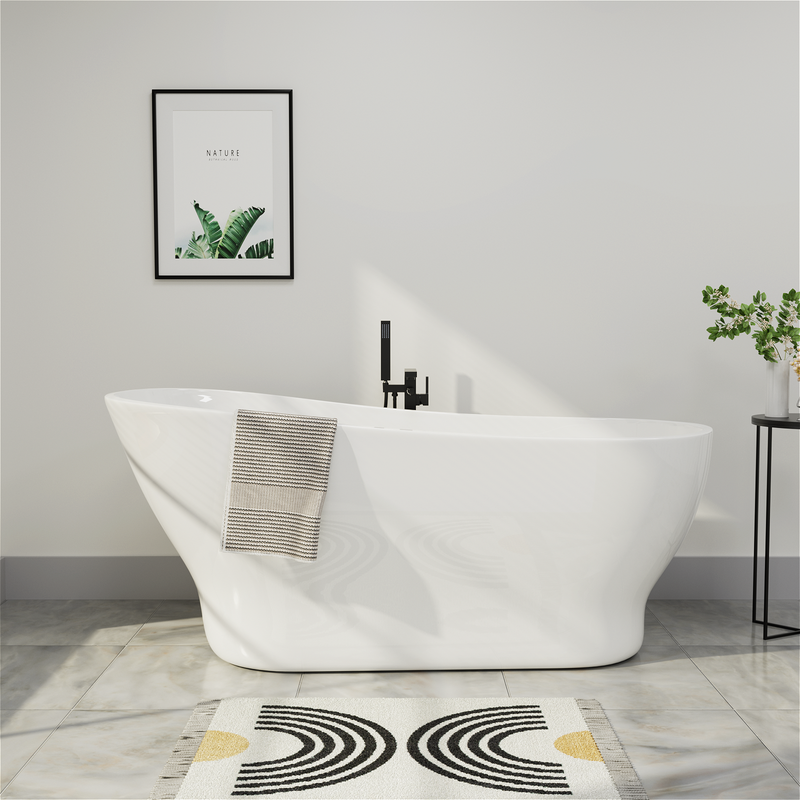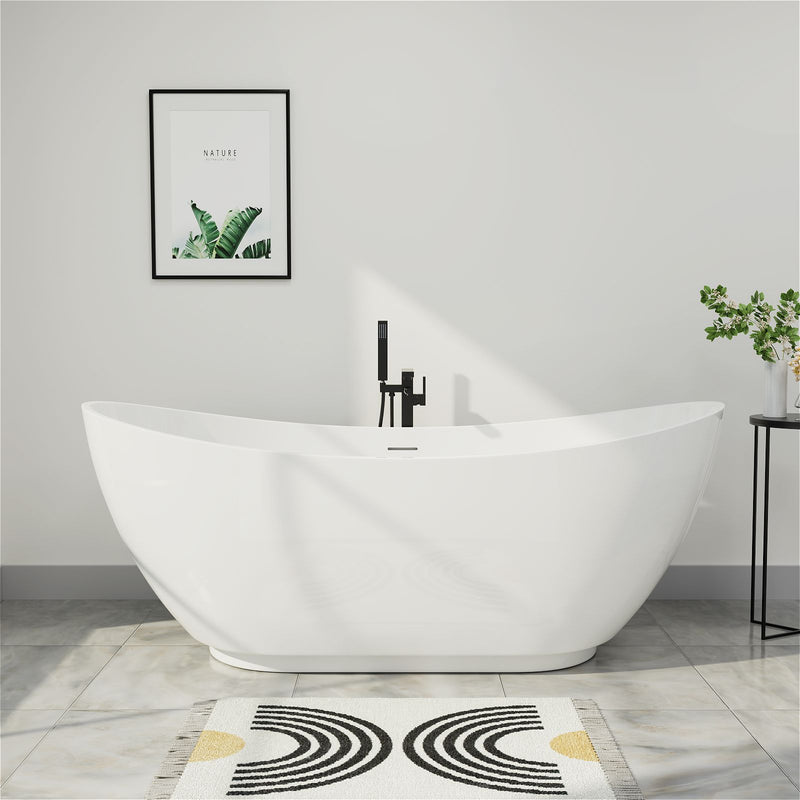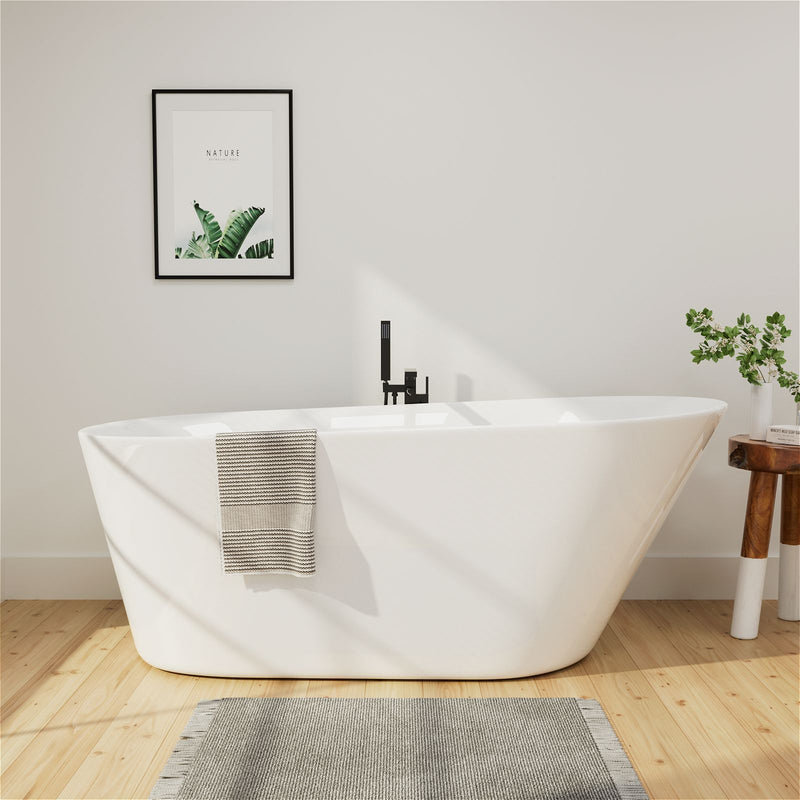A bathtub drain is a device used to drain the water from a bathtub after a bath. It consists of several components, such as the drain flange, drain plug, overflow drain, and drain pipe. A bathtub drain is not only a functional component of your bathroom, but also an aesthetic component, as it enhances the look and style of your bathtub.
Choosing the Size of a Bathtub Drain
Choosing the right bathtub drain is important for efficient drainage, prevention of clogging, and compatibility with your plumbing system.
A properly sized drain ensures smooth water flow, minimizing standing water, odors, and unpleasant long-term water stains. Additionally, knowing the right bathtub drain size can save you from unnecessary worry.
Standard Sizes of Bathtub Drains
Bathtub drains come in two main sizes:
1.5-inch: This is the standard drain size for most home bathtubs, including alcoves, freestanding bathtubs, and clawfoot bathtubs. These types of drains allow standing water to drain smoothly from your home.
2-inch: This drain size is common in larger, higher-capacity bathtubs, such as whirlpools, soaking tubs, and jacuzzi tubs. The increase in size allows for more efficient drainage, which can solve the problem of standing water that larger bathtubs must deal with.
To avoid installation problems when replacing your drain, make sure you measure the size of your existing pipe before purchasing a replacement.
Measuring Your New Tub Drain
Measure the Drain Size
The first step in measuring your new tub drain is to determine the size of your existing drain. Use a tape measure to measure the diameter of the drain hole at the bottom of the tub. Most standard tubs have a drain diameter of about 1.5 to 2 inches, but it's important to measure accurately because some older or custom tubs may not have a standard size.
Measure the Overflow Pipe Location (If You Can Use a Thick Pipe)
The overflow pipe is responsible for draining excess water out of the tub when the water in the tub reaches a certain level. To measure the location of the overflow pipe, measure the distance from the center of the overflow plate to the center of the main drain. This measurement is critical because it ensures that the overflow pipe is properly aligned with the drain assembly. When measuring, always make sure that the tub is fully accessible, otherwise it will cause installation difficulties or leaks.
Measure the Overflow Depth
The overflow depth is the vertical distance from the bottom of the tub to the center of the overflow hole. This measurement determines how much water the tub can hold before the overflow begins to work. To measure, place a ruler or measuring tape at the center of the tub bottom (where the drain is) and extend it to the overflow hole. Accurately measuring the overflow depth ensures that the drain assembly's overflow plate is properly installed on the tub wall and not too high or too low.
Measure the Waste Arm Length
The drain shoe is the horizontal pipe that connects the main drain to the plumbing under the tub. To measure the drain shoe's length, measure from the center of the drain to the point where the shoe connects to the main pipe.
Measure the Tub Depth/Height
Measuring the depth or height of your tub is critical to selecting a drain assembly that matches the tub's overall size and water capacity. To measure the tub's depth, place the measuring tape at the deepest point of the tub (usually near the drain) and extend it vertically to the top edge of the tub.
Evaluate Access to the Installation
Before finalizing your drain assembly selection, evaluate the access to your tub plumbing. Check if there is an access panel, open space under the tub, or if you need to install through the wall behind the tub. Insufficient access will affect the ease of installation and may limit the types of drain assemblies that can be used.
Bathtub Drain Spare Parts
Drain Body: The drain body is the main component that is installed in the tub drain. It provides a housing for other components and ensures smooth drainage.
Stopper: The stopper is the movable component that controls the water flow. It can be operated by different mechanisms such as foot-operated, lift-and-turn, push-and-pull, or lever-operated. The type of stopper mechanism depends on the specific tub drain.
Overflow Plate: The overflow plate is located on the side of the tub near the faucet. It acts as an additional drain when the water level reaches a certain level, preventing overflow.
Trigger: The trigger is a key component of a tub drain with a trigger mechanism. It is connected to the overflow plate and controls the position of the stopper.
Gaskets and Seals: Gaskets create a watertight connection between the different parts of the tub drain assembly. They help prevent leaks and ensure proper operation.
Strainer: The strainer is a perforated or mesh component that sits above the drain opening and prevents large debris or objects from entering the drain system.
Mounting Hardware: Various screws, nuts, and washers are used as mounting hardware to secure the different parts of the tub drain assembly in place.
Extension kits: In some cases, if the standard bathtub drain is not long enough, an extension kit can be used to adjust the length of the drain to fit a specific bathtub or plumbing configuration.
The standard covers common spare parts and components for bathtub drain assemblies. The availability of specific spare parts and the specific components may vary by manufacturer and bathtub drain model. If repairs or replacements are required, it is recommended to consult the manufacturer or a professional plumber to ensure that the correct spare parts are used for your bathtub drain.
Raw Materials for Bathtub Drains
The following are some common raw materials used to make bathtub drains:
Copper: Copper is widely used and has good corrosion resistance and antibacterial properties. It is occasionally used in bathtub drains, especially in traditional or vintage style designs.
Brass: Brass is often used in bathtub drains for its corrosion resistance and durability. It is an alloy of copper and zinc that provides strength and stability to the drain.
Bronze: Bronze is an alloy of copper with other metals, such as tin or aluminum. It is known for its high strength, corrosion resistance, and beauty. Bronze bathtub drains are often used for their elegant and timeless appearance.
Nickel Bronze: Nickel bronze is an alloy of copper, nickel, and zinc. It has excellent corrosion and wear resistance and is suitable for bathtub drains in high humidity environments.
Stainless steel: Stainless steel is another commonly used bathtub drain material. It has excellent corrosion resistance, high strength, and durability. Stainless steel drains are able to withstand harsh environments and provide long-lasting performance.
Plastic: Some bathtub drains are made of durable plastic materials such as PVC (polyvinyl chloride) or ABS (acrylonitrile butadiene styrene). Plastic drains are lightweight, affordable, and corrosion-resistant.
These are just a few examples of the raw materials commonly used in bathtub drain manufacturing—they combine beauty, durability, and corrosion resistance. Manufacturers may also use other specialized materials based on specific requirements or design preferences.
How to Install a Bathtub Drain?
Step 1 Prepare the Work Area
First, make sure the work area is clean and free of any debris or obstructions. Remove any old drain components or remnants from previous installations.
Step 2 Check Compatibility
Check that the bathtub drain is compatible with the bathtub and plumbing system. Make sure the new drain is the right diameter and length for your tub.
Step 3 Apply Sealant
Apply plumber putty or silicone sealant around the tub drain flange. This helps create a watertight seal between the drain and the tub surface.
Step 4 Insert the Drain
Insert the drain body into the tub drain, making sure it is firmly seated. Apply gentle pressure and twist clockwise to tighten it into place.
Step 5 Tighten the Drain
Use a drain wrench or pliers to tighten the drain body until it fits snugly against the tub. Be careful not to overtighten or you may damage the drain or tub.
Step 6 Install the Overflow Plate
If your tub has an overflow, install the overflow plate into the designated opening of the tub. Secure with screws according to the manufacturer's instructions.
Step 7 Detect Leaks
Once the tub drain is installed, fill the tub with water and check for leaks around the drain. If you find leaks, tighten further or apply additional sealant as needed.
How to Replace a Bathtub Drain?
Step 1 Remove the Old Drain
Remove the existing drain by removing the old drain assembly. Use a drain wrench or pliers to loosen and unscrew the drain body from the tub. Turn counterclockwise until it is loose and can be removed.
Step 2 Clean the Drain
Clean the drain thoroughly to remove any debris or residue from the old drain. Scrub the area with a mild detergent and a brush to ensure the new drain has a clean surface.
Step 3 Install the New Tub Drain
Install the new tub drain following the installation steps above. Apply sealant, insert the drain body, tighten, and install the overflow plate if applicable.
How to Repair a Tub Drain?
Step 1 Identify the Problem
Detect the specific problem that needs repair in the tub drain. It could be a leak, a malfunctioning stopper assembly, or other issues.
Step 2 Disassemble the Drain
Disassemble the tub drain to gain access to the parts that need repair. This may include removing the drain body, stopper assembly, or other necessary parts.
Step 3 Repair or Replace Parts
Repair or replace the malfunctioning parts, depending on the specifics of the problem. This may include repairing leaks, replacing damaged stops, or other specific issues.
Step 4 Reassemble the Drain
After completing the necessary repairs or replacements, reassemble the bathtub drain, making sure all parts are properly aligned and secured.
Step 5 Functional Test
Test the repaired bathtub drain for proper operation. Fill the bathtub with water, operate the stop to verify that it is functioning properly, and check for leaks.
If you are not confident in your plumbing skills, it is recommended that you seek the help of a professional plumber to install, replace, or repair the bathtub drain. They have the professional expertise to complete the job with precision and ensure optimal performance and functionality of the pipe.
FAQs About Bathtub Drain
Q: What is the purpose of a bathtub drain?
A: The bathtub drain is the outlet for the water inside the bathtub. It allows water to flow through the drain and prevent the bathtub from overflowing.
Q: Do you replace the bathtub drain yourself or hire a professional?
A: Although you can replace the bathtub drain yourself, it is recommended that you hire a professional plumber, especially if you lack plumbing experience. A professional plumber needs the necessary tools and expertise to ensure a proper installation and minimize the risk of leaks or damage to the tub.
Q: How do I determine the correct size for my tub drain?
A: To determine the correct size, measure the diameter and length of the existing drain or tub opening. Standard tub drains are typically 1.5 inches to 2 inches in diameter. Measurements are critical for air conditioning systems. If you are unsure, consult a professional plumber or refer to the manufacturer's specifications.
Q: What are the different types of tub drain plugs?
A: There are many types of tub drain plugs, including foot-operated, lift-and-turn, push-pull, and wrench-operated. Each plug operates differently and has its own drain opening and closing mechanism.
Q: How do I prevent my tub drain from clogging?
A: To prevent clogging, avoid pouring hair, soap residue, or other debris down the drain. Use a drain strainer or cover to filter larger particles. Clean the drain regularly, such as by flushing it with boiling water or using a mixture of baking soda and vinegar. If the clog persists, consider using a drain cleaner or contacting a professional plumber.
Q: Do bathtub drains work with all types of bathtubs?
A: Bathtub drains are designed to be compatible with most standard bathtubs. However, it is important to make sure the diameter and length of the drain match the specifications of your bathtub. Some specialty bathtubs may require a specific type of drain, so it is recommended that you refer to the manufacturer's guidelines or seek the advice of a professional.
Q: Can a bathtub drain be installed without an overflow feature?
A: Yes, we offer bathtub drains without an overflow feature. These drains do not come with an overflow plate or device. It is important to consider the safety hazards of a non-overflow drain and make sure your bathtub is equipped with other appropriate safety measures.
Q: How can I keep my bathtub drain smelling fresh?
A: To keep my bathtub drain smelling fresh, clean it regularly. Pour a mixture of baking soda and vinegar down the drain and then rinse it with boiling water. You can also use an enzyme-based drain cleaner specifically designed to eliminate odors. Avoid pouring harsh chemicals down the drain as they can damage the plumbing system.
Q: How often should I replace my bathtub drain?
A: The lifespan of a bathtub drain depends on its quality, usage, and maintenance. Generally speaking, if your bathtub drain is functioning well and shows no signs of wear or damage, it does not need to be replaced. However, if you experience frequent leaks, corrosion, or other problems, you may want to consider replacing your bathtub drain.
Q: Can a bathtub drain be repaired? Or does it need to be replaced entirely?
A: A bathtub drain can usually be repaired if the problem is limited to a specific component, such as a faulty stopper mechanism or a leaking seal. However, if important parts of the drain are damaged, you may need to replace the entire bathtub drain assembly.





